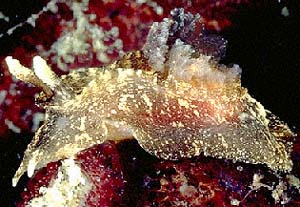
Goniodoris meracula
Burn, 1958
Order: NUDIBRANCHIA
Suborder: DORIDINA
Family: Goniodorididae
DISTRIBUTION
Southeastern Australia: From Pearson Island, South Australia to the mid New South Wales coast, from intertidal to 65m depth. [Burn [in] Shepherd & Thomas, 1989]
PHOTO
Sorrento Pier, Port Phillip Bay, Victoria, March 1986. Upper right - Whole animal crawling over ascidian colony. Lower left - Two animals on ascidian colony which has been torn open to show hidden egg ribbons. Lower right - An animal nestled in a burrow it has eaten out in the ascidian colony. Note foot folded up the walls of the burrow. Photos: Bill Rudman.
The body shape is typical for the genus with a high body and pointed tail. The edge of the mantle is extended into a very thin, narrow, rim-like flange, minutely crenulate and roughened, continuous all round the body except behind the gills. The oral tentacles are large, and the separate gills are arranged in a circlet around the anal papilla. The body is translucent with a mottled pattern of browns and white, the proportion of each varying in different specimens. From my notes on living animals I describe the colour as " Translucent body covered with dense specks of either dark rusty brown or creamy white. The colours are not uniform over the surface but in aggregations of one colour or the other giving a patchy brown and white appearance to the head, walls of the foot and tail. The dorsum is mostly brown-speckled with some small measure of white mottling. The rhinophore stalks are almost entirely brown while the clubs are predominantly white but with a lot of brown patching. The gills are similar in colour to the rhinophores, only the very distal tips having any white speckling. From the base of each gill there is a ridge running to the anus, the ridges appearing as spokes of a wheel whose hub is the anus. It grows to approximately to 20 mm in length.
Animals are usually found associated with colonial acidians. They usually feed by burrowing into the colony, forming a hole not much larger than the slug. The foot is usually folded up the sides of the hole so the slug's body is effectively surrounded by its own foot. In some instances the exit/entrance hole in the ascidian colony is smaller than the slug, suggesting that it has grown in size since entering the ascidian colony. In these cases the slug is almost invisible from the outside. The most obvious indication of the slug's presence are its egg ribbons which it deposits on the ascidian usually around the entrance to its burrow, but sometimes inside the burrow.
Reference:
• Burn, R.F. (1958). Further Victorian Opisthobranchia. Journal of the Malacological Society Australia, 1(2): 20-36, pls. 6-7.
• Burn, R. (1989). Opisthobranchs, in Shepherd, S.A. & Thomas, I.M. Marine Invertebrates of Southern Australia, Part II. South Australian Government Printing Division, Adelaide. 900 pages
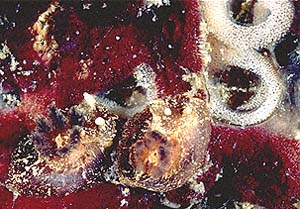
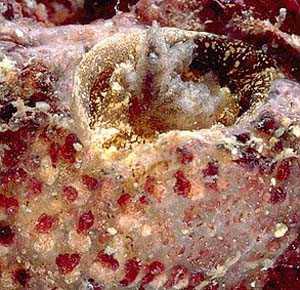
Rudman, W.B., 2003 (September 3) Goniodoris meracula Burn, 1958. [In] Sea Slug Forum. Australian Museum, Sydney. Available from http://www.seaslugforum.net/find/gonmerac
Related messages
Goniodoris meracula from southeastern Australia ?
April 7, 2008
From: Andrew Newton
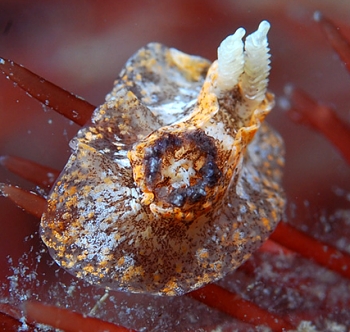
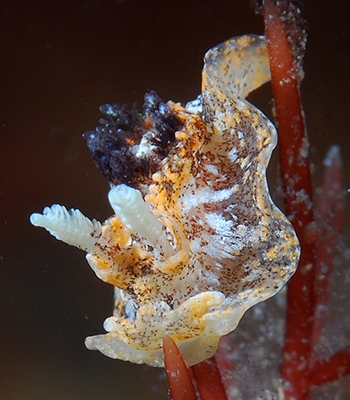
Hello Bill,
Can you help me with an ID. I photographed this ?Polycera under St Leonards Pier in about 3 m.
Have never seen this one here before.
Locality: St Leonards Pier, 3 m, Victoria, Port Phillip, 14 October 2007, Sandy silty. Length: 5 mm. Photographer: Andrew Newton.
Andrew Newton
apnewton@gmail.com
Newton A. P., 2008 (Apr 7) Goniodoris meracula from southeastern Australia ?. [Message in] Sea Slug Forum. Australian Museum, Sydney. Available from http://www.seaslugforum.net/find/20970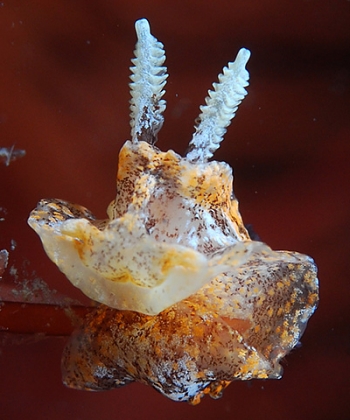
Dear Andrew,
This is not a polycerid, but a goniodorid called Goniodoris meracula. It's usually found near, or on, the ascidian it is eating. Often it lives in the hole it excavates in the ascidian's tissue, so it certainly looks a bit awkward crawling over this branching red sea weed. Have a look at the Fact Sheet and the other messages attached to it for more background information on this species
Best wishes,
Bill Rudman
Goniodoris meracula from S.E. Australia
September 2, 2003
From: John Chuk
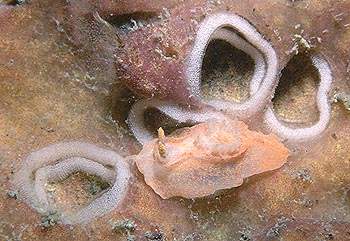
Dear Bill,
Following on from Rachel's message, here are images of a specimen of Goniodoris meracula photographed at Portsea Pier, Victoria, Australia on 30th of January 2003. The specimen measured 16mm in length and was found nestled in a colonial ascidian on a pier pylon at a depth of 5m.
The upper image is of the specimen in motion across the ascidian. Several egg-ribbons are visible. This specimen was translucent white in colour with fine, bright orange spots all over the body.
The lower left image is an in situ shot of the specimen as found resting in a cup-shaped depression in the ascidian colony. The foot margin was rolled up and the specimen had assumed a rounded shape. It was well disguised and looked more like a small sponge colony than a nudibranch.
The lower right image is of the foot and was taken after I had partially rotated the specimen out of the depression it was found in. The specimen did not move and foot margin remains rolled up.
Best wishes,
John.
jchuk@giant.net.au
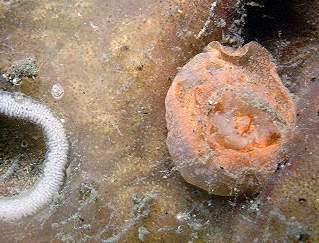
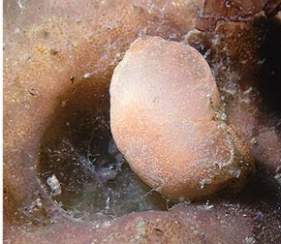
Thanks John,
I have not seen an animal of this colour before. I assume it is a colour form of G. meracula. Thanks for this nice series of photos which show how it hides in a nice little 'plughole' it eats out of the ascidian colony. They seem to lay an egg ribbon around each hole.
Best wishes,
Bill Rudman
Goniodoris meracula - egg ribbons
September 1, 2003
From: Rachel Przeslawski
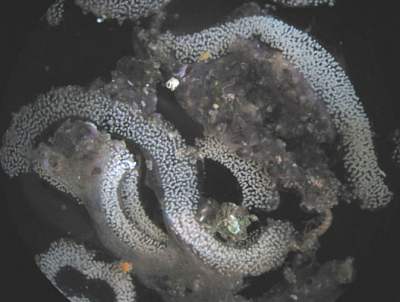
Hi Bill,
While out surveying, I noticed these egg ribbons nestled into a colonial ascidian under two different boulders at Wollongong, New South Wales [Australia]. Upon closer inspection, I saw an adult Goniodoris meracula buried under the ascidian at each boulder. I brought them back to the lab to confirm egg mass identity, and they kindly laid the exact same egg mass I had seen in the field (as well as mating on glass for me to snap a fuzzy nudi photo). The veligers were interesting because they and their capsules were so elongated ... I've seen similar elongated capsules before in very mature egg masses, but the veligers seemed to have left or died because there were only shells left in seemingly intact capsules.
Any ideas why this would happen?
Thanks!
Rachel Przeslawski
rachelp@uow.edu.au
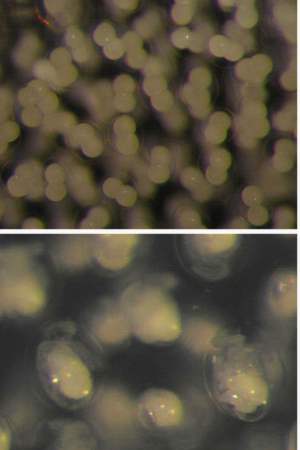
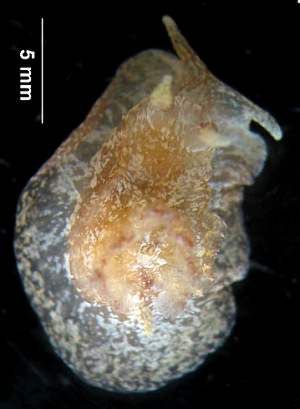
Dear Rachel,
I think the shape of the egg capsules is species specific, some being quite spherical while others are more elongate. Concerning death in the egg capsules would suggest the larvae were killed by adverse conditions, disease or attack by protozoa. Goniodoris meracula is definitely one of those species which is very difficult to find. As you experienced, it is usually only found after its much more noticeable egg masses are deposited.
Best wishes,
Bill Rudman
Eggs of Goniodoris meracula
April 8, 1998
From: Kirsten Benkendorff
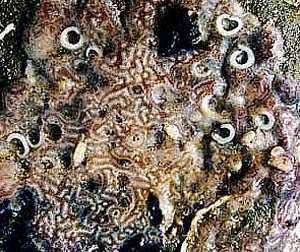
Hi Bill,
I found the eggs of this Goniodoris sp. under a boulder embedded in an ascidian. If anyone has seen anything like this before could you please let me know. I am interested in the chemical defense mechanisms of molluscan egg masses and it is possible that this nudibranch is making the most of the unpalatability of its host ascidian. I would also be interested to hear about eggs on sponges or anything else which is likely to contain toxic chemicals.
Thanks a lot,
Kirsten Benkendorff
PS note my new email address
kb06@uow.edu.au
Benkendorff, K., 1998 (Apr 8) Eggs of Goniodoris meracula. [Message in] Sea Slug Forum. Australian Museum, Sydney. Available from http://www.seaslugforum.net/find/67This species of Goniodoris is usually found nestled into "craters" it has eaten away in the compound ascidian colonies it calls home. In the lower photo above you can see an animal with its large foot folded up on each side of the body and only the gills are clearly visible. As they eat more of the ascidian away they form a hidden chamber in which they lay their eggs. I do not know whether they use chemicals from the ascidians to protect then from predators. It may be that once they have formed the protective "crater" or "cavern" in which they live they are effectively hidden from potential predators...Bill.
Rudman, W.B., 1998 (Apr 8). Comment on Eggs of Goniodoris meracula by Kirsten Benkendorff. [Message in] Sea Slug Forum. Australian Museum, Sydney. Available from http://www.seaslugforum.net/find/67